10 LiveAgent Alternatives for Your Customer Support Team in 2025

Table of contents
LiveAgent is a powerful help desk software that helps businesses centralize all their support-related customer communication.
The platform allows businesses to offer multichannel support across live chat, email, social media, phone, and a knowledge base. It also offers a ticketing system to assign and track customer inquiries, automations to streamline repetitive tasks, and analytics to gauge team performance.
Table of Contents
- Why Choose A LiveAgent Alternative?
- 10 LiveAgent Alternatives for 2025
- Wrapping Up
- Frequently Asked Questions (FAQs)
Why Choose A LiveAgent Alternative?
While LiveAgent is a robust help desk ticketing system, it has a few drawbacks than can be limiting for your customer support team.
One of the biggest challenges with LiveAgent is that the platform has a complex interface that is rather difficult to set up and use. This means support agents will have to undergo extensive training in order to get started with the platform.
The interface was not user friendly. Have tried many different chat agents to settle on the one we use, but Live Agent had the worst interface by far. It was difficult to get help or how to manuals. Even chatting with their support was a challenge. The biggest issue with the interface was the amount of items listed and no real clear understanding of the titles used for features.
–LiveAgent user on G2
LiveAgent users have reported a few other limitations as well.
- Vendor support is limited and customers have reported that the LiveAgent support team is slow to respond to queries.
- Onboarding assistance is only available for members who have opted for higher pricing plans.
- Another downside is how the pricing is structured with an upper limit on features, even in the most expensive plan. For instance, if you want to use WhatsApp as a channel for communication, you are only allowed to integrate three numbers with the LiveAgent ticketing system even in its highest pricing tier.
The good news is that there are better alternatives than LiveAgent that offer a number of robust features for customer support.
In this article, we take a look at 10 LiveAgent articles that you should consider for your support team.
10 LiveAgent Alternatives for 2025
Here’s quick comparison of different alternatives to LiveAgent, their key features, and pricing.
| LiveAgent Alternative | Key Features | Pricing |
|---|---|---|
| Hiver | Multi-channel support, easy setup in Gmail, unlimited automations in Elite plan, email management, live chat, smart automations, workload distribution, knowledge base, analytics. | Lite: $19/user/month; Pro: $49/user/month; Elite: $79/user/month; Free Trial: 7 days |
| Zendesk | Ticketing system, AI and automation, Zendesk Chat, help center, routing intelligence. | Suite Team: $55/agent/month; Suite Growth: $89/agent/month; Suite Professional: $115/agent/month; Enterprise options available; Free Trial: 14 days. |
| Freshdesk | Multi-channel support, parent-child ticketing, intelligent ticket dispatch, Freddy AI, analytics. | Growth: $29/user/month Pro: $59/user/month Enterprise: $99/user/month |
| Zoho Desk | AI suggestions, live chat, work modes, social media management. | Standard: $15.60/user/month; Professional: $25.20/user/month; Enterprise: $38.40/user/month; Free Trial: 15 days. |
| Help Scout | Shared inbox, Beacon for in-app support, help center, automations | Standard: $22/user/month; Plus: $44/user/month; Pro: $65/user/month; Free Trial: 15 days. |
| Front | Automation and workflows, shared inbox solution, analytics, live chat. | Starter: $19/person/month; Growth: $59/person/month; Scale: $99/person/month; Premier: $229/person/month; Free Trial: 7 days |
| Intercom | AI bot Fin, in-app messaging, mobile app support, guided product tours | Essential: $39/month; Advanced: $99/month; Expert: $139/month |
| Drift | Drift Engage, live chat, reporting and analytics | Premium: Starts at $2,500/month; Advanced and Enterprise: Price on request; Free Trial: 14 days. |
| HubSpot Service Hub | Ticketing system, customer portal, live chat | Service Hub Free; Starter: $50/month for 2 users; Professional: $450/month for 5 users; Enterprise: $1200/month for 10 users; Free Trial: 14 days. |
| Kayako | Live Chat, self-service portal, SingleView to manage multi-channel customer interactions | Inbox: $15/agent/month; Growth: $30/agent/month; Scale: $60/agent/month; Enterprise: $100/agent/month. |
Below is a detailed explanation of each of the LiveAgent alternatives for your support team. These options offer critical functionalities that your team needs to deliver consistent and seamless support.
1. Hiver
Hiver is a powerful multi-channel help desk that is built specifically for teams on Google Workspace.
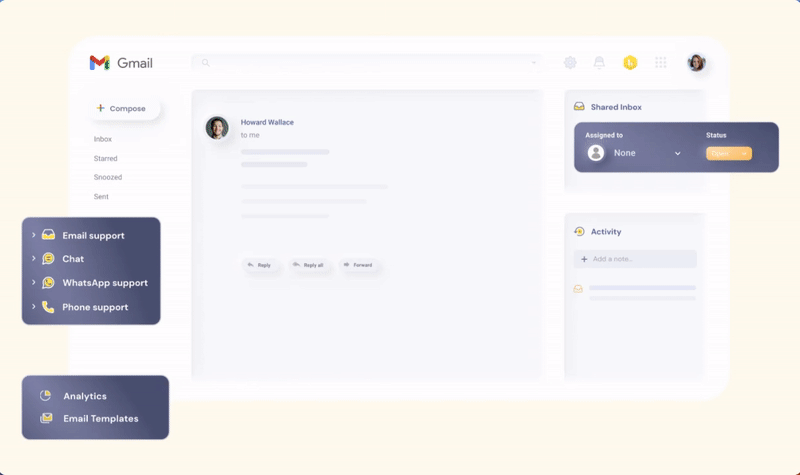
With Hiver, you can easily support customers across email, live chat, and phone. You can also build your own knowledge base with Hiver – driving self-service
It is one of the most robust LiveAgent alternatives for customer support teams. This is because Hiver works right inside Gmail, meaning that it is incredibly easy to set up and super simple to use. Aside from this, Hiver does not have an upper cap in higher pricing plans unlike LiveAgent.
For instance, members of Hiver’s Elite plan can set up unlimited automations whereas LiveAgent users do not have this option even in its ‘large business’ plan.
Here are some of the key features of Hiver:
- Email Management: With Hiver, every incoming customer query is converted into a ticket and assigned to the right team members. This way no conversation gets lost and every query gets a dedicated owner, ensuring accountability.
- Live Chat: Hiver’s chat widget can be easily set up within a few minutes – right within Gmail. It helps customers get instant and seamless support for their queries. The best part is that you can offer both email and live chat support right from Gmail. There’s no need to switch between multiple tools or tabs. You can also create live chat templates to respond faster to recurring issues.
- Smart Automations: Routine tasks such as assigning or tagging emails can be automated easily. This allows your agents to focus on more complex tasks at hand. Hiver’s automations can be used to assign emails to specific team members to ensure quicker and more relevant responses. For instance, any email with the term “Billing” or “Payment” can be routed to the finance team.
- Workload Distribution: With Hiver, you get a bird’s eye view of who is working on what. It allows you to ensure that work is distributed equally among team members. If a team member is not available, they can easily update their status using a toggle control.
- Knowledge Base: Hiver’s Knowledge Base is an excellent self-service channel. You can create and host a repository of help articles to enable customers to resolve their queries without getting in touch with a human agent. In cases where customers cannot find the answer to a query, they can create a support ticket directly from the knowledge base.
- Insightful Reporting and Analytics: Leverage Hiver’s robust analytics to improve team performance and elevate your customer experience. The platform offers multiple pre-built reports that help you monitor metrics such as average response times to ensure timely customer support. You can also keep an eye on customer satisfaction by tracking CSAT scores. You can even build custom reports to measure the metrics that actually matter to you.
One of the biggest advantages with Hiver is that it offers timely vendor support across chat and email around the clock, irrespective of the pricing tier. You also get free onboarding assistance across all pricing plans to help you get the best out of the platform.
Pricing:
Hiver offers three pricing plans.
- Lite: $19/user per month
- Pro: $49/user per month
- Elite: $79/user per month
Free Trial: 7 days. No credit card required
Hiver has revolutionized the way I manage my Gmail inbox, and I couldn’t be more impressed. The standout feature for me is the seamless collaboration it enables within Gmail. Shared inboxes and the ability to assign emails to team members have transformed our communication workflow. It’s incredibly easy to track who is handling what, ensuring that nothing falls through the cracks.
–Hiver user on G2
2. Zendesk
Zendesk is a customer service platform that provides businesses with a suite of tools to offer seamless support.
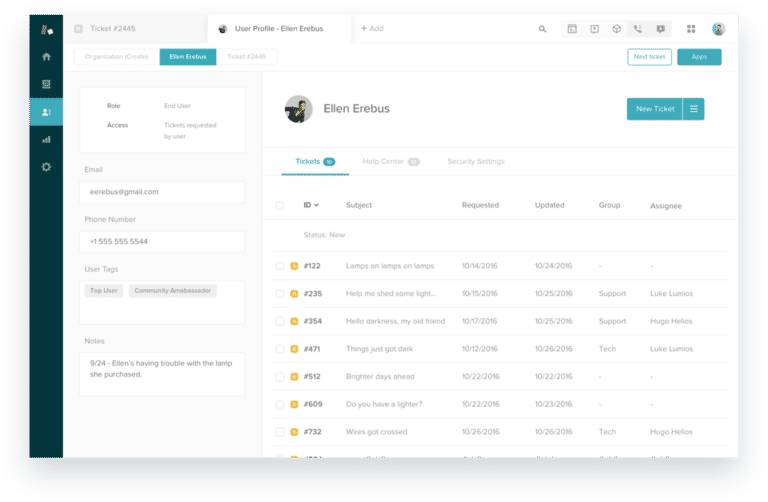
Zendesk’s core feature is its ticketing system, which allows businesses to centralize customer inquiries, support requests, and issues in one location. Tickets can be organized, prioritized, and assigned to appropriate agents. Aside from this, Zendesk also offers self-service options, automation capabilities, and mobile accessibility. All of this enables your support agents to manage customer interactions effectively.
Here are some of the key features of Zendesk:
- AI and automation: Zendesk’s AI is capable of detecting customer sentiment from conversations and suggest responses. This is quite helpful in providing contextual support to customers.
- Zendesk Chat: Enable 24/7 customer support with Zendesk’s bots. These bots answer common questions, ensuring support teams don’t have to deal with higher ticket volumes.
- Help Center: Setup a knowledge base with Zendesk so that customers can find solutions to basic questions by themselves.
- Intelligent Routing: Ensure that every query is routed to the right agent. You can categorize queries based on channel, conversation type, priority level, etc.. This way every request receives the expert attention it requires.
Despite its extensive features, Zendesk has a few drawbacks.
- One of Zendesk’s biggest disadvantages is its complex pricing plan. Often you will end up paying for features you don’t use. Whereas the ones you actually need costs extra. For instance, with a solution like Hiver, you get access to all critical support features at 56% less cost than Zendesk.
- Personalized onboarding and around-the-clock support costs extra. In comparison, both onboarding assistance and 24/7 customer support is included across all of Hiver’s pricing plans.
- A clunky and non-intuitive interface. Support teams would have to spend a lot of time and effort to get used to the software.
- Training your agents to use the platform can cost anywhere between $1,500 to $2,800.
You Might Also Like: Hiver vs Zendesk: A Comprehensive Comparison Guide
Pricing:
Zendesk has three tiers of pricing for small to large-sized businesses.
- Suite Team: $55 per agent per month
- Suite Growth: $89 per agent per month
- Suite Professional: $115 per agent per month
For enterprise companies, Zendesk has two tiers of pricing:
- Suite Enterprise: $150 per agent per month
- Additional and more powerful enterprise plans start at $215 per agent per month
Free Trial: 14 days
Did You Know?
Among allLiveAgent alternatives, Hiver offers all critical support features at 56% lesser cost than Zendesk, making it a cost-effective option for businesses.
3. Freshdesk
Freshdesk is a cloud-based customer support solution suitable for businesses of various sizes.
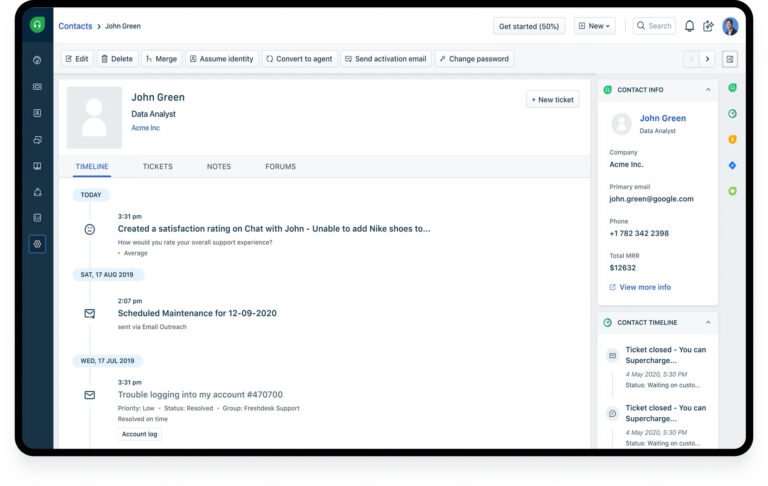
Freshdesk enables businesses to engage with customers across various communication channels, including email, chat, phone, and social media, consolidating interactions into a unified dashboard.
The platform also offers a forever free plan for support teams that have a budget constraint.
Here are some of the key features of Freshdesk:
- Parent-child ticketing: Freshdesk allows you to split a complex (parent) ticket into several smaller (child) tickets. These tickets are then assigned to the appropriate agents so that they can be resolved in parallel. This way agents can work more efficiently and offer faster resolutions.
- Intelligent ticket dispatch: You can assign tickets to agents based on factors like workload, skills, and other criteria. This ensures that tickets are directed to agents who are well-equipped to handle specific types of issues.
- Freddy AI: Freshdesk’s AI enables customers to find answers to basic queries from the knowledge base any time they want. This reduces wait times drastically and improves customer satisfaction.
- Analytics: Freshdesk offers pre-built reports to help you understand how support agents are performing. You can also get access to Freshdesk’s dashboards to get clear insights into important help desk metrics such as first response time, average resolution time, CSAT scores, etc. This allows you to identify bottlenecks and improve your customer support process.
However, Freshdesk does have a few limitations.
- Freshdesk has a complicated interface which means users might take time to learn and get used to the platform. In contrast, Hiver works seamlessly inside Gmail and users can get started with using it right away.
- The platform does not integrate well with Google Workspace products. This means that whenever a new ticket is created, it cannot be actioned from within Gmail. Users will have to switch to Freshdesk’s platform to act on it.
You Might Also Like: Freshdesk vs Zendesk: What to Choose in 2025
4. Zoho Desk
Another popular LiveAgent alternative is Zoho Desk. It can be used to provide seamless multi-channel customer support across email, social media, live chat, phone, and website.
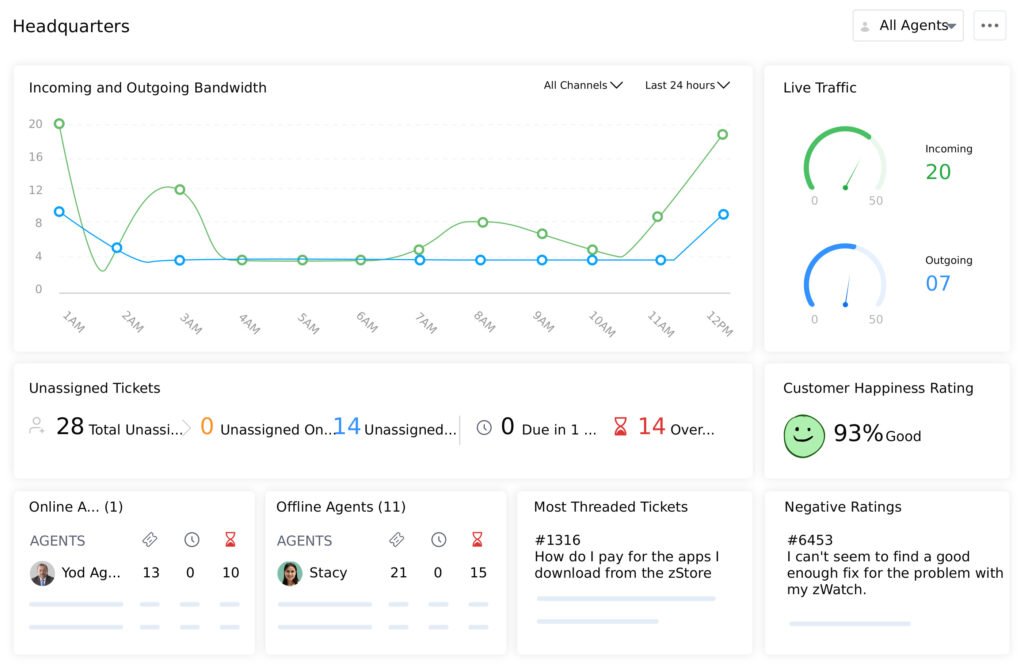
Here are some key features of Zoho Desk:
- Zia: Zoho Desk’s AI, Zia, suggests relevant responses while support agents are talking to customers, based on historical interactions, knowledge base articles, and common issue resolutions. This feature accelerates response times and ensures consistency in communication.
- Live Chat: Embed Zoho Desk’s live chat widget on your website, mobile application, and help center with zero coding. Customers can initiate instant conversations with support agents. Aside from this, support agents can proactively engage with website visitors by initiating chat sessions based on predefined conditions, such as time spent on a particular page or specific actions taken on the site.
- Work Modes: Zoho Desk provides multiple ticket views that can help teams organize tickets according to priority, due dates, and status. This assists support agents in effectively handling their workload by swiftly identifying which tickets require immediate attention.
- Social Media Management: You can turn social media posts and comments into support tickets directly from Zoho Desk’s interface.
Even though Zoho Desk offers multiple features to streamline customer support, some users have reported a few disadvantages with the platform.
- While Zoho Desk offers customization options, making extensive modifications or integrations may require technical expertise. Businesses with complex customization needs might find it challenging to implement certain changes without assistance.
- Some users have also reported concerns about the response time of Zoho Desk’s customer support.
Pricing:
Zoho Desk offers four types of pricing plans.
- Standard: $15.60 per month per user
- Professional: $25.20 per month per user
- Enterprise: $38.40 per month per user
Free Trial: 15 days
5. Help Scout
Help Scout is a user-friendly platform designed to facilitate efficient and personalized customer service.
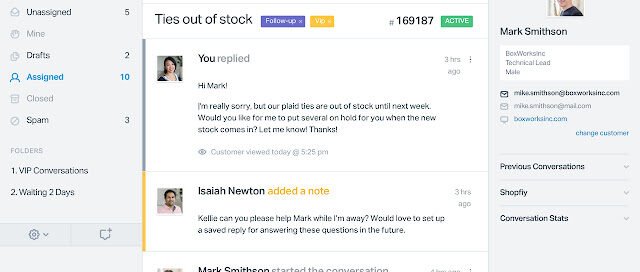
The platform provides a shared inbox solution for collaborative communication, allowing multiple team members to access and respond to customer emails seamlessly.
Help Scout also turns customer inquiries into manageable tickets, helping support teams prioritize, track, and resolve them effectively.
Here are some key features of Help Scout:
- Beacon: Help Scout’s Beacon is a feature that enables businesses to provide in-app support and assistance to customers. It has a live chat functionality that allows customers to initiate real-time conversations with a company’s support team. Beacon can also recommend how-to guides and help articles to your customers by sourcing content from your knowledge base.
- Messages: This feature enables support teams to proactively reach out and offer help to customers any time they seem stuck. For instance, say a new user is using your product. You can use Messages to proactively guide the user to your help center to help them find answers to any questions they might have.
- Help Center: Help Scout allows you to build a help center with zero code. It includes a knowledge base where businesses can create and organize articles, FAQs, and documentation. This serves as a repository of information that customers can access to find answers to common questions.
- Automations: Help Scout’s smart automations help you automate repetitive tasks and ensure that critical messages are routed to the right agent or escalated if required.
Help Scout has certain limitations that you should keep in mind when you consider the tool.
- The platform has a learning curve and it takes time for users to get accustomed to the interface.
- Help Scout also doesn’t allow teams to create SLAs directly. You will have to use a third-party application in order to do this.
- While the platform offers extensive email management features, users have reported that internal and external conversations often overlap.
Pricing:
Help Scout offers the following pricing plans:
- Standard: $22 per user per month
- Plus: $44 per user per month
- Pro: $65 per user per month
Free Trial: 15 days
You Might Also Like: 10 Help Scout alternatives for your customer support team in 2025
6. Front
Front is a customer operations platform that enables businesses to seamlessly manage customer communication and deliver timely support.
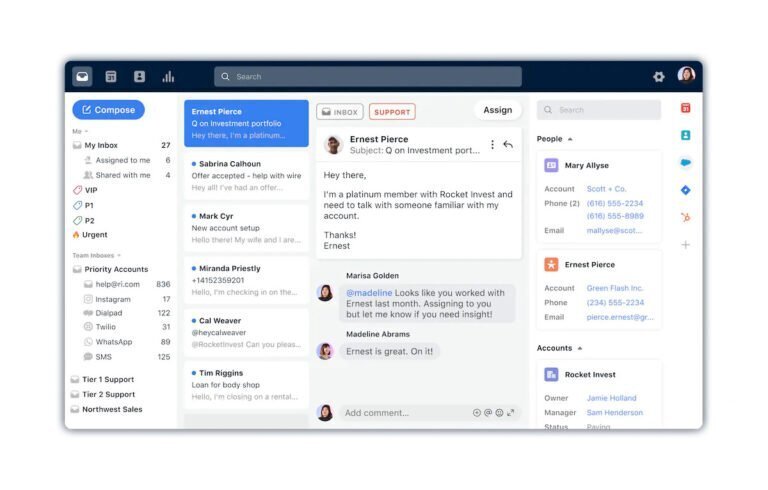
With Front, businesses can offer customer support across channels such as email, SMS, live chat, social media, and WhatsApp. The platform also offers internal collaboration features, allowing team members to comment, discuss, and collaborate on messages.
Here are some of Front’s key features:
- Automation and Workflows: Front offers automation features to streamline repetitive tasks and create workflows, enhancing team efficiency in managing communication. This includes auto-routing incoming emails, auto-triggering feedback surveys, and more.
- Analytics and Reporting: Front provides analytics and reporting tools, allowing teams to track performance metrics, response times, and other key indicators to assess customer satisfaction.
- Live Chat: Front’s offers a live chat option that is easy to set up and use. You can add it on your website, mobile app, or inside your product. This way your customers can reach out to you easily, irrespective of the channel. The feature also enables you to upload images and videos to your conversations so that customers can have complete context during your chat sessions.
Front does have a few drawbacks that can impact the efficiency of your customer support team.
- A complex interface with a steep learning curve. Your agents will need extensive training before they can get started with using the platform.
- Lack of seamless integration with applications such as Slack or Gmail means that you will find yourselves switching between multiple tabs to get your work done.
- Analytics in Front can be quite difficult to understand.
- When it comes to pricing, you will also find that Front charges nearly 1.5x more for critical support features in comparison to a help desk like Hiver.
Pricing:
Front offers four pricing options.
- Starter: $19 per person per month
- Growth: $59 per person per month
- Scale: $99 per person per month
- Premier: $229 per person per month
Free Trial: 7 days
7. Intercom
Intercom is a customer messaging platform that leverages AI to enhance support communication, automate processes, and deliver personalized experiences.
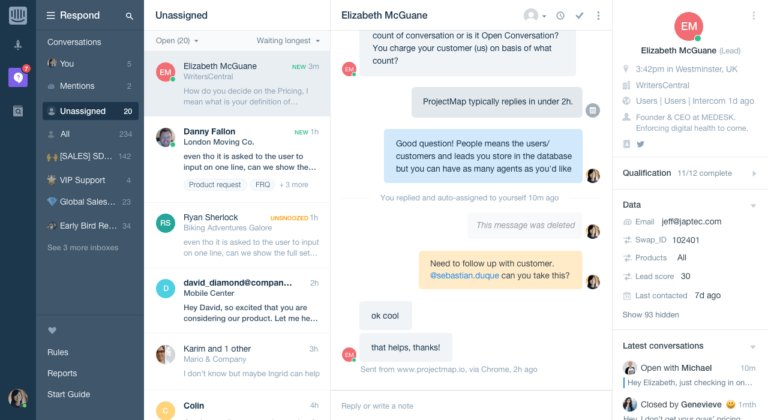
Intercom enables businesses to engage with customers through real-time messaging across various channels, including in-app chat, email, and on websites.
Here are some of Intercom’s key features:
- Fin: Intercom’s AI bot, Fin can be used to provide instant and accurate answers to customer queries. In situations where a customer query is too complex, Fin can seamlessly loop in a human agent. This ensures a consistent experience for customers and reduces support ticket volumes.
- In-app messaging: Businesses can send targeted messages to users within their mobile applications. This is particularly useful when onboarding new customers or launching new features that you want users to try out.
- Mobile App: With Intercom, businesses can offer support to users within their mobile app. They can also offer self-service options inside the app.
- Product tours: Intercom offers the ability to create interactive product tours and personalized onboarding experiences. This helps new users get acclimatized with the features of a product or service, improving adoption and satisfaction.
The problem with Intercom, however, is that it is quite expensive, especially for smaller businesses.
Pricing:
Intercom has three pricing tiers
- Starter: $74/month
- Pro: Custom pricing
- Premium: Custom pricing
You Might Also Like: 10 Best Intercom Alternatives
8. Drift
Drift is an AI powered customer engagement platform that allows businesses to engage with website visitors, generate leads, and drive user interactions with real-time communication.
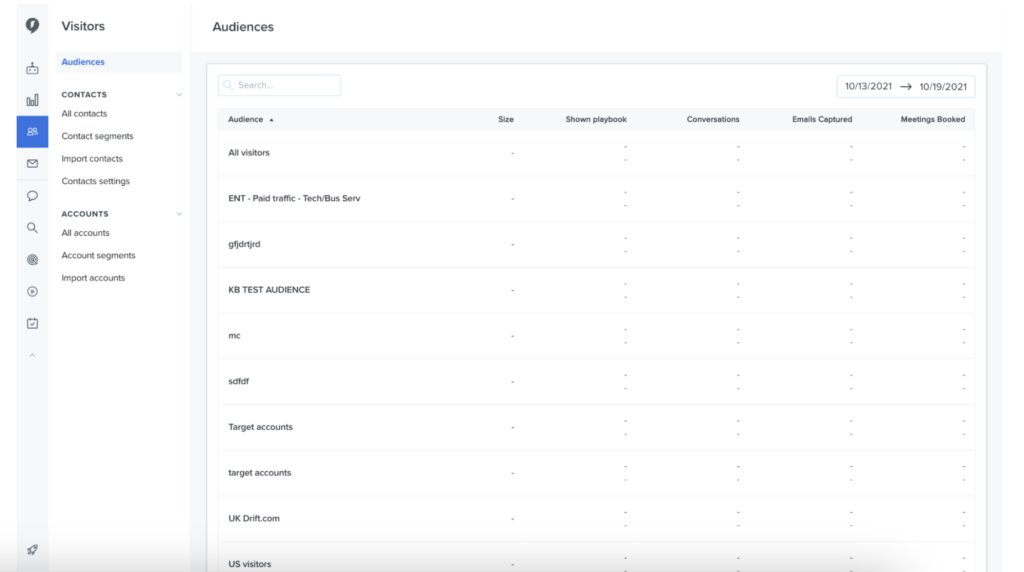
The platform offers several features that can be used to provide instant answers to customer queries and help website visitors find all the information they need whether they are making a purchase or simply navigating a website.
Here some of Drift’s key features:
- Drift Engage: You can leverage chatbots to initiate conversations with website visitors based on certain triggers, such as specific pages visited or time spent on the site. Bots help qualify leads and provide immediate responses.
- Live Chat: Businesses can engage in real-time conversations with website visitors through live chat, allowing for immediate assistance and personalized interactions.
- Reporting and analytics: Drift offers extensive, actionable insights into customer conversations. It allows you to track your website performance and identify the pages that bring you the highest conversions. This way you can identify how you can elevate revenue from your website.
While Drift offers an extensive range of features, it is important to keep in mind that the software has a few limitations.
- Drift’s basic plan starts at $2500 per month. This can be quite expensive for a lot of businesses.
- The platform has a rather complicated interface which can be difficult for users to get used to.
Pricing:
Drift offers three types of pricing options:
- Premium: Starts at $2,500/month
- Advanced: Price on request
- Enterprise: Price on request
Free Trial: 14 days
9. HubSpot Service Hub
Service Hub by HubSpot is a robust tool that allows businesses to offer personalized support to their customers. Businesses can connect Service Hub with HubSpot’s CRM and get a holistic view of all customer interactions.

Service Hub includes a ticketing system that allows businesses to track, organize, and prioritize customer inquiries, issues, and support requests in a centralized dashboard.
Here are some of HubSpot Service Hub’s key features:
- Ticketing System: Service Hub includes a ticketing system that allows businesses to manage and track customer inquiries, support requests, and issues in a centralized location.
- Customer Portal: Customers can log in to the Customer Portal to view and manage their support tickets, check the status of their inquiries, and track the progress of ongoing support issues. The portal can be integrated with your knowledge base. This integration allows customers to access articles, FAQs, and documentation that can help them find answers to common questions or troubleshoot issues independently.
- Live Chat: Service Hub offers a live chat feature, enabling real-time communication between support agents and customers on your website.
However, HubSpot Service Hub has a few cons that can hinder the efficiency of your support team.
- Implementing and fully utilizing HubSpot Service Hub may have a learning curve
- While HubSpot Service Hub is customizable to a certain extent, some users have reported that there are limitations for highly specific and unique requirements.
- Another disadvantage
Pricing:
HubSpot Service Hub offers four pricing plans:
- Service Hub Free
- Service Hub Starter: $50 per month for 2 users
- Service Hub Professional: $450 per month for 5 users
- Service Hub Enterprise: $1200 per month for 10 users
Free Trial: 14 days
10. Kayako
Kayako is a multi-channel help desk platform that is designed to help businesses manage and streamline their customer support operations.
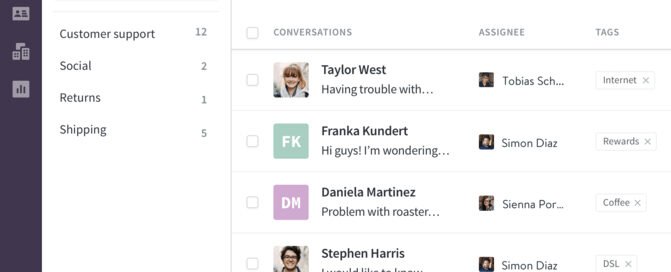
Kayako provides a holistic view of the customer journey so that any time a customer raises a complaint, agents have detailed insight into critical information. This enables them to provide faster, contextual support.
Here are some of Kayako’s key features:
- Live Chat: Kayako’s Live Chat can be used to provide real-time customer support. Simply add it to your website, mobile application, or help center, and you’re good to go.
- Self-service portal: Businesses can create and maintain a knowledge base within Kayako, providing customers with self-service resources, FAQs, and documentation to find answers independently.
- SingleView: Kayako SingleView aims to consolidate and present all relevant information about a customer in a single, unified interface. The goal is to offer a 360-degree view of the customer, allowing support agents to have a holistic understanding of the customer’s journey, preferences, and previous interactions.
All this being said, Kayako has a few significant drawbacks as reported by its users.
- Users find it difficult to build comprehensive reports simply because of the complexity of the reporting dashboard.
- Users have also complained that Kayako’s customer support is not very reliable and that the costs are too high for what the platform offers.
Pricing:
Kayako offers four pricing options:
- Inbox priced at $15 per agent per month
- Growth priced at $30 per agent per month
- Scale priced at $60 per agent per month\
- Enterprise priced at $100 per agent per month
You Might Also Like: Top 10 Kayako alternatives in 2025
Wrapping Up
Every LiveAgent alternative we’ve talked about has something unique about it – be it features or pricing. It is important that you opt for a platform that aligns with your specific needs and preferences.
For instance, if cost is a factor, Zoho Desk is a great option. If you need powerful real-time messaging, Intercom can be your go-to platform.
If you’re looking for a good balance between ease of use and powerful support features, check out Hiver. It offers a robust multi-channel helpdesk that works inside Gmail.
Hence, you don’t have to learn any new software, and can get started from day one.
If you’d like to know how Hiver can help you deliver highly efficient customer support, give it a spin with our free 7 day trial.
Frequently Asked Questions (FAQs)
Here are some commonly asked questions on LiveAgent alternatives
1. What are the main drawbacks of using LiveAgent for customer support?
LiveAgent’s main drawbacks include a complex interface, limited vendor support, and restricted features in higher pricing plans.
2. Can Hiver integrate with Google Workspace?
Yes, Hiver is built for teams on Google Workspace and works seamlessly on top of Gmail.
3. What are some cost effective alternatives to LiveAgent?
Hiver and Zoho Desk are two cost-effective alternatives to LiveAgent.
4. How does Hiver handle email management?
Hiver converts every incoming customer email into a ticket and assigns it to the right team members, ensuring accountability and no lost conversations.
5. Are there any free trials available for these LiveAgent alternatives?
Yes, most LiveAgent alternatives like Hiver, Zendesk, Freshdesk, and others offer free trials ranging from 7 to 15 days

































